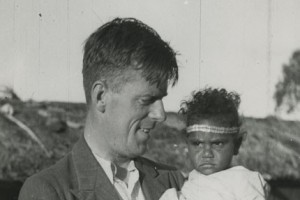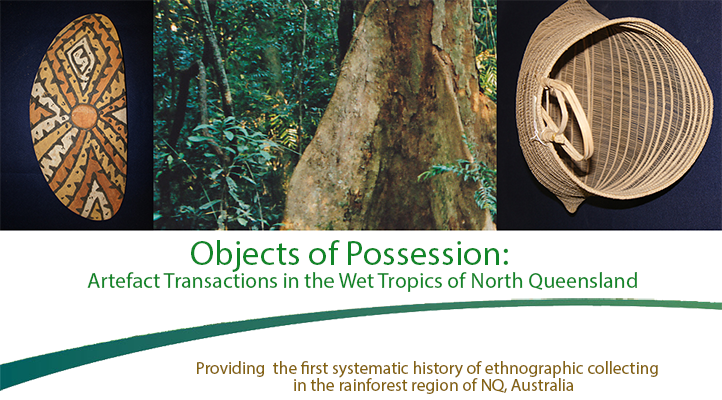
Norman Tindale holding a child from Monamona Mission near Kuranda, North Queensland, 1938. Source: South Australian Museum Archives, http://www.samuseum.sa.gov.au/collections/information-resources/archives/tindale-dr-norman-barnett-aa-338
Author: Russell McGregor
Collector: Norman Barnett Tindale
Born: 12 October 1900 in Perth, Western Australia
Died: 19 November 1993 in Palo Alto, California
Active: Tindale carried out intermittent, though intensive, forays as an ethnographic collector in the Wet Tropics from the 1920s to the 1960s. He also collected extensively throughout Australia.
Background biography: Norman Tindale was a colossus of Australian museum ethnography. He collected Aboriginal artefacts from around the continent, especially from northern and central Australia, and made innumerable films, sound recordings, maps, drawings, photographs, sketches and documentary records of Aboriginal culture. Tindale compiled genealogies that spanned over 50,000 Indigenous individuals. He was among the first to give Aboriginal studies an ecological slant and was a pioneer of scientific techniques of archaeological excavation in Australia. Among his contributions to knowledge is a map of Aboriginal tribal boundaries that still provides the foundations for maps of Aboriginal Australia today.
Born into a devout Salvation Army family, Tindale spent much of his childhood and early teens (1907-1915) in Tokyo, where his father worked for the Salvation Army mission. Back in Australia, he took up a position as a cadet at the Adelaide Public Library in 1917, then as an entomologist’s assistant at the South Australian Museum in 1919. Tindale’s transformation from entomologist to anthropologist came after his 1921-22 expedition to Groote Eylandt in the Gulf of Carpentaria. There, his discussions with a Ngandi man named Maroadunei convinced him that Aboriginal groups possessed sharply-bounded tribal territories, against the anthropological orthodoxy of the day that Aboriginal territories were rather amorphous and lacked distinct borders. This revelation motivated Tindale’s mapping of tribal territories for the next half-century.
In 1928 Tindale was appointed part-time ethnologist at the South Australian Museum, though he still held a position as assistant entomologist at the museum until 1933. Through the 1930s he was a key participant in the annual expeditions to central Australia undertaken by members of the Board for Anthropological Research at the University of Adelaide. These expeditions, orientated toward physical anthropological investigations, left a lasting imprint on Tindale’s disciplinary practice.
In 1938 Tindale, along with Harvard University physical anthropologist Joseph Birdsell, embarked on an eighteen-month field trip that took them around Australia and Tasmania. The primary purpose of this joint Harvard-Adelaide Universities Expedition was to investigate racial intermixing and the biological absorption of people of mixed Aboriginal-European descent into the wider white society. However, it was on this expedition that Tindale and Birdsell made ‘a fundamental discovery in Australian anthropology’: the inhabitants of the rainforests of North Queensland were racially distinct from all other mainland Aboriginal groups, akin to the Tasmanians and living relicts of the first people to inhabit Australia. This categorisation of the Aboriginal people of the Wet Tropics was a keystone in Tindale and Birdsell’s trihybrid theory of Aboriginal origins.
To buttress their assertions of the distinctiveness of the Aboriginal people of the North Queensland rainforests, Tindale and Birdsell adduced evidence concerning their languages, material culture, social structure, cultural practices and physical features. However the attribute that captured the public imagination was the claimed ‘pygmoid’ stature of the rainforest people. For decades thereafter, the popular press regaled the public with tales of the ‘pygmies’ of North Queensland. Among anthropologists and scientists, Tindale and Birdsell’s racial classification had some, though never universal, support, which dwindled by the 1970s. However, the category ‘rainforest Aboriginal people’, first formulated by Tindale and Birdsell, still persists, though now stripped of its racial traits and focused on environmental, social and material culture characteristics.
Tindale was closely attentive to both the environmental influences on Aboriginal cultures and the ways in which Aboriginal people shaped the natural environments around them. An early exponent of the view that Aboriginal burning practices have moulded the biological configuration of Australia, he suggested that this was the case even in the relatively fire-resistant environment of wet-tropical rainforest. In elucidating Aboriginal-environmental interactivity, Tindale brought to bear a unique combination of expertise in geology, biology and archaeology as well as in ethnography and ethnology.
Throughout his career, Tindale remained in many ways a natural scientist who transferred his skills of empirical observation and meticulous record-keeping to the social domain. For him, it was essential to record ethnographic data at a level of detail and density that would facilitate the researches of later investigators. Thus, for example, he collected not only artefacts but also samples of the raw materials from which they were made, as well as filming and photographing the process of manufacture. Forever seeking to understand Australia’s deep past, Tindale acknowledged that his own researches were merely part of an ever-growing and ever-changing mosaic of information and interpretation.
Sources: Philip G. Jones, ‘Norman B. Tindale, 12 October, 1900 – 19 November, 1993: An Obituary’, Records of the South Australian Museum, vol.28, no.2, 1995, pp.159-176, https://www.anu.edu.au/linguistics/nash/aust/nbt/obituary.html
Russell McGregor, Indifferent Inclusion: Aboriginal People and the Australian Nation, Canberra, Aboriginal Studies Press, 2011.
Norman B. Tindale & Joseph B Birdsell, ‘Results of the Harvard-Adelaide Universities Anthropological Expedition, 1938-1939: Tasmanoid Tribes in North Queensland,’ Records of the South Australian Museum, vol.7, no.1, 1941, pp.1-9.
